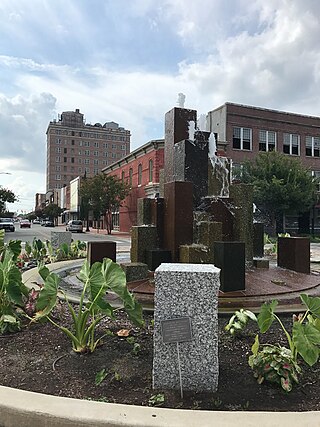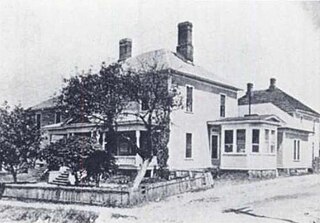
Wayne County is a county located in the U.S. state of North Carolina. As of the 2020 census, the population was 117,333. Its county seat is Goldsboro, and it is home to Seymour Johnson Air Force Base.

Goldsboro, originally Goldsborough, is a city in and the county seat of Wayne County, North Carolina, United States. The population was 33,657 at the 2020 census. It is the principal city of and is included in the Goldsboro, North Carolina Metropolitan Statistical Area. The nearby town of Waynesboro was founded in 1787, and Goldsboro was incorporated in 1847. It is the county seat of Wayne County.
WakeMed Health and Hospitals is a 919-bed healthcare system with multiple facilities placed around the metropolitan Raleigh, North Carolina area. WakeMed's main campus is located on New Bern Avenue in Raleigh, North Carolina. WakeMed serves multiple counties throughout the state and specializes in a variety of services including cardiology, gastroenterology, neurology, orthopedics, high-risk pregnancy, children's care, trauma, physical rehabilitation and critical care transport.

UNC Rex Hospital is a general hospital located in Raleigh, North Carolina. It is the capital city's oldest hospital, founded by a bequest from John T. Rex (1771–1839), a local tanner and slave owner. Originally located on what is now Dorothea Dix campus, and later on St. Mary's Street, Rex is now located in west Raleigh at the corner of Blue Ridge Road and Lake Boone Trail. Rex Health Care's services include oncology, heart and vascular, surgical services, rehabilitation, emergency department, urgent care, women's services, and wound healing.
UNC Health Wayne is a nonprofit hospital affiliate of UNC Health, a health care system in North Carolina and the largest private employer in Wayne County. Its name changed from Wayne Memorial Hospital when it entered into a management agreement with UNC Health in 2015 and in 2022, the hospital changed its name from Wayne UNC Health Care to UNC Health Wayne.
ECU Health Medical Center is a hospital located in Greenville, North Carolina. It is the primary teaching hospital for East Carolina University's Brody School of Medicine and is the flagship medical center for ECU Health. ECU Health is a Level 1 Trauma Center, one of 6 in the state of North Carolina. It is the only level I trauma center east of Raleigh, and thus is the hub of medical care for a broad and complicated rural region of over 2 million people. ECU Health Medical Center is the largest employer in Eastern North Carolina and 20th overall in the state.
A group home, congregate living facility, care home, adult family home, etc., is a structured and supervised residence model that provides assisted living and medical care for those with complex health needs. Traditionally, the model has been used for children or young people who cannot live with their families or afford their own homes, people with chronic disabilities who may be adults or seniors, or people with dementia and related aged illnesses. Typically, there are no more than six residents, and there is at least one trained caregiver there 24 hours a day. In some early "model programs", a house manager, night manager, weekend activity coordinator, and four part-time skill teachers were reported. Originally, the term group home referred to homes of 8 to 16 individuals, which was a state-mandated size during deinstitutionalization. Residential nursing facilities, also included in this article, may be as large as 100 individuals in 2015, which is no longer the case in fields such as intellectual and developmental disabilities. Depending on the severity of the condition requiring one to need to live in a group home, some clients are able to attend day programs and most clients are able to live normal lifestyles.
North Carolina State University College of Veterinary Medicine is an American educational institution located in Raleigh, North Carolina that offers master's and doctorate-level degree programs; interdisciplinary research in a range of veterinary and comparative medicine topics through centers, institutes, programs and laboratories; and external engagement through public service programs and activities.
CarolinaEast Medical Center, the flagship hospital of CarolinaEast Health System, is a 350-bed acute care hospital located in New Bern, North Carolina. CarolinaEast Health System provides both inpatient and outpatient care to residents in Craven, Jones, Pamlico and surrounding counties in eastern and coastal North Carolina. The hospital has dedicated units for cardiac, neurological, intensive and intermediate care, pediatrics, women's care, adult psychiatry and cancer care, as well as general surgical and medical units.
Spartanburg Regional Healthcare System(SRHS) is one of South Carolina's largest healthcare systems. SRHS draws patients primarily from the areas of Spartanburg, Cherokee, Union, and Greenville counties (all located in the Piedmont region of South Carolina), as well as Rutherford and Polk counties (located in western North Carolina). Spartanburg General Hospital was organized under the authority of the South Carolina General Assembly in 1917. It officially became the Spartanburg Regional Health Services District, Inc., a political subdivision of the State of South Carolina, by the charter granted by the Secretary of State of South Carolina on May 1, 1995.

CaroMont Regional Medical Center is a not-for-profit hospital located in Gastonia, North Carolina, United States. The hospital was organized in 1946 as a memorial to soldiers who died in World War II, and the present Court Drive facility opened in 1973.

The Federal Medical Center, Lexington is a United States federal prison in Kentucky for male or female inmates requiring medical or mental health care. It is designated as an administrative facility, which means that it holds inmates of all security classifications. It is operated by the Federal Bureau of Prisons, a division of the United States Department of Justice. The facility also has an adjacent minimum-security satellite camp for female inmates.

Cherry Hospital is an inpatient regional referral psychiatric hospital located in Goldsboro, North Carolina, United States. As one of three psychiatric hospitals operated by the North Carolina Department of Health and Human Services, it provides services to 38 counties in the eastern region of North Carolina. It is part of the Division of State Operated Healthcare Facilities within the Department of Health and Human Services, which oversees and manages 14 state-operated healthcare facilities that treat adults and children with mental illness, developmental disabilities, and substance use disorders. The Division's psychiatric hospitals provide comprehensive inpatient mental health services to people with psychiatric illness who cannot be safely treated at a lower level of care.

Leonard Hall is a historic educational building located on the campus of Shaw University in Raleigh, North Carolina. Built in 1881 and originally named Leonard Medical Center, it became known as Leonard Medical School, and then Leonard Hall. It was established when medical schools were professionalizing and was the first medical school in the United States to offer a four-year curriculum. It was also the first four-year medical school that African Americans could attend.

Lincoln Community Health Center (LCHC) is an outpatient primary care facility located in Durham, North Carolina that replaced Lincoln Hospital in 1968. LCHC offers a wide range of health services including adult medicine, pediatrics, dental, social work/mental health services, family care nursing and outreach into the home. Prenatal and family planning services are available at the Center in cooperation with the Durham County Health Department.
Duke University Hospital is a 1062 -bed acute care facility and an academic tertiary care facility located in Durham, North Carolina, United States. Established in 1930, it is the flagship teaching hospital for the Duke University Health System, a network of physicians and hospitals serving Durham County and Wake County, North Carolina, and surrounding areas, as well as one of three Level I referral centers for the Research Triangle of North Carolina. It is affiliated with the Duke University School of Medicine.

Henryton State Hospital is a now-demolished hospital complex in Marriottsville, in southern Carroll County, Maryland, just across the Howard County line. The complex was located within Patapsco Valley State Park and along its southern end runs CSX's Old Main Line Subdivision and is very close to the Henryton Tunnel. The Henryton State Hospital center, or the Henryton Tuberculosis Sanatorium as it was called, was erected in 1922 by the Maryland Board of Mental Hygiene. It was established as a facility to treat African Americans suffering from tuberculosis. This was one of the first such facilities in Maryland erected to provide African Americans with the same level of treatment as white people. Other accounts state that this was more of containment Hospital rather than a treatment facility. They contend that Henryton was used more for the exile and quarantine of tuberculosis patients.

George Hughes Kirby (1875–1935) was an American physician and psychiatrist, administrator, and educator, who contributed to the advancement of psychiatry in the United States.

Sagar Institute of Mental Health and Neuro and Allied Sciences (VIMHANS) is a mental healthcare institution in South Delhi. It was founded in 1987 as a tribute to the Indian psychiatrist Vidya Sagar.

Zucker Hillside Hospital is a psychiatric facility that opened in 1926, relocated to its present address in 1941, and was renamed in 1999 to its present name.











